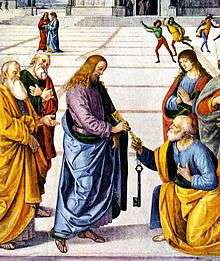Coadjutor bishop
| Part of a series on the |
| Hierarchy of the Catholic Church |
|---|
 |
| Ecclesiastical titles (order of precedence) |
|
|
Liturgical titles |
|
Administrative and pastoral titles
|
|
Consecrated and professed titles |
|
Organization titles |
|
|
A coadjutor bishop (or bishop coadjutor) is a bishop in the Catholic, Anglican, and (historically) Eastern Orthodox churches whose main role is to assist the diocesan bishop in the administration of the diocese.[1][2] The coadjutor (literally, "co-assister" in Latin) is a bishop himself, although he is also appointed as vicar general. The coadjutor bishop is, however, given authority beyond that ordinarily given to the vicar general, making him co-head of the diocese in all but ceremonial precedence. In modern times, the coadjutor automatically succeeds the diocesan bishop upon the latter's retirement, removal, or death.
In Different Traditions
Roman Catholic Church
In the Roman Catholic Church, a coadjutor bishop is an immediate collaborator of the diocesan bishop, similar to an auxiliary bishop.[3][4] However, unlike auxiliary bishops, coadjutors are given the right of succession to the episcopal see. When the diocesan bishop dies, retires, resigns, or is reassigned, the coadjutor automatically becomes the next bishop of the local Church (diocese). Until then, the diocesan bishop appoints the coadjutor to act as vicar general. He needs to be ordained and generally holds a titular see until his succession.
In modern church practice, the appointment of a coadjutor is usually done in cases where a diocesan bishop feels that he will not be able to continue in his position for health reasons or impending retirement. In these cases, the Pope may assign a coadjutor in order to give him time to become familiar with the diocese that he will eventually take over. For example, Bishop Dennis Marion Schnurr of the Diocese of Duluth, Minnesota, was named Coadjutor Archbishop of the Archdiocese of Cincinnati, Ohio, in 2008 to succeed aging Archbishop Daniel Edward Pilarczyk.
At times, the appointment of a coadjutor is used to discreetly remove a diocesan bishop who has become involved in scandal or other problems. An example of this occurred in the Archdiocese of Dubuque in the 1940s, when Archbishop Francis Beckman involved the archdiocese in what turned out to be a dubious mining scheme. When the scheme fell apart and resulted in serious financial problems for Beckman and the archdiocese, Bishop Henry Rohlman of Davenport, Iowa, was appointed Coadjutor Archbishop of Dubuque. While Beckman was allowed to retain the office of Archbishop, it was made clear to him by the Holy See that the actual power rested with Rohlman.
Prior to the reform of the Code of Canon Law in 1983, a distinction was made between coadjutor bishops cum jure succesionis (lit. "with the right of succession") and those without. Some coadjutors were appointed with the right of succession, and others without such a right (the latter were usually appointed for archbishops with particularly large dioceses who also held other important posts and to honor certain auxiliary bishops). For an example of a coadjutor without right of succession, see John J. Maguire, coadjutor archbishop of New York (1965-1980). Now, no coadjutor is appointed without the concomitant right of succession.
An Apostolic Vicar can also have a coadjutor, who, like him, will be a titular bishop.
Anglican Communion
In some provinces of the Anglican Communion, a bishop coadjutor (the form usually used) is a bishop elected or appointed to follow the current diocesan bishop upon the incumbent's death or retirement. For example, in the Episcopal Church in the United States of America, when a diocesan bishop announces his or her retirement, a special diocesan convention is held to elect a coadjutor. Usually, the coadjutor serves with the incumbent for a short time before the latter's retirement, at which time the coadjutor becomes the diocesan bishop. Bishops coadjutor are also appointed in the Reformed Episcopal Church.
The role of 'assistant-bishop' (with no expectation to succeed the diocesan see) in the Church of England is fulfilled by a suffragan.
There have been bishops coadjutor in the Anglican Church of Australia who have lacked the right of succession to the diocesan see.
Notes
- ↑ Patrich, Joseph (2001). The Sabaite Heritage in the Orthodox Church from the Fifth Century to the Present. Peeters Publishers. ISBN 9789042909762.
- ↑ Hamilton, Bernard (2016-12-05). The Latin Church in the Crusader States: The Secular Church. Routledge. ISBN 9781351887052.
- ↑ "Canon 403 §3". 1983 Code of Canon Law. Libreria Editrice Vaticana. Archived from the original on 15 January 2010. Retrieved 6 February 2015.
- ↑ "Canon 403 §1". 1983 Code of Canon Law. Libreria Editrice Vaticana. Archived from the original on 15 January 2010. Retrieved 6 February 2015.
